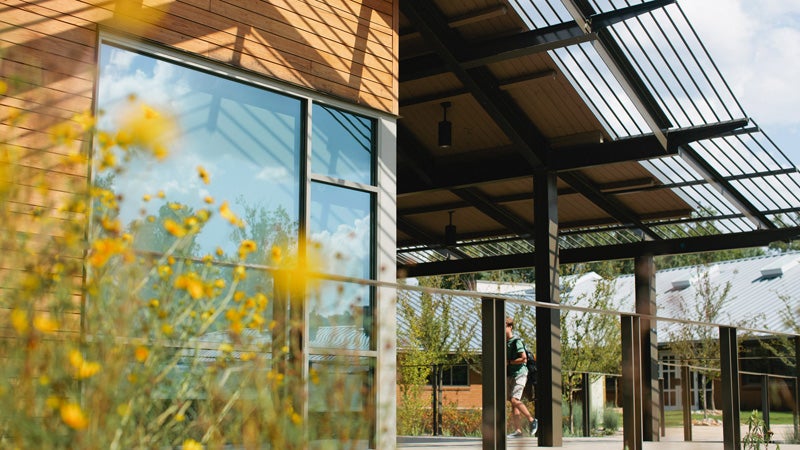Indian Springs School achieves Silver LEED certification
Published 4:50 pm Tuesday, March 14, 2017

- Indian Springs School earned points across six environmental categories from the U.S. Green Building Council for the construction of three new classroom buildings and a new administration building. (CONTRIBUTED)
FROM STAFF REPORTS
INDIAN SPRINGS – Indian Springs School’s three new classroom buildings and new administration building have been awarded Silver LEED (Leadership in Energy and Environmental Design) certification by the U.S. Green Building Council, a Washington, D.C.-based nonprofit that promotes sustainability in building design, construction and operation.
Considered a standard for sustainable building in the United States and more than 150 countries and territories worldwide, LEED certification recognizes green building features that conserve energy, save water, lower carbon emissions and create healthier environments.
For its Silver LEED designation, Indian Springs earned significant points across six environmental categories: innovative design, sustainable sites, water efficiency, energy and atmosphere, materials and resources, and indoor environmental quality.
Specific areas in which Springs received recognition include:
- Innovation in design: Use of daylight, unobstructed views, open space and low-mercury lighting; and development of a classroom curriculum highlighting the buildings’ sustainable design features.
- Sustainable sites: Preferred parking for low-emitting and fuel-efficient vehicles; storm water management to limit pollution of natural water flows to Springs’ lake; use of roofing materials that reduce “heat islands” and their impact on microclimates and wildlife and human habitats; and reduction of light pollution to increase night sky visibility.
- Water efficiency: Reduction of total water use for irrigation by 93 percent; and reduction of potable water use by 30 percent.
- Energy and atmosphere: Energy costs reduced by 34 percent; use of alternatives to ozonedepleting refrigerants to cool the buildings; and green power (purchase of renewable energy to provide at least 35 percent of the buildings’ electricity).
- Materials and resources: Construction waste management (67 percent of construction waste was diverted from landfills); and use of recycled content and regional materials.
- Indoor environmental quality: Air quality management plan during construction; use of low-emitting materials (paint, sealants); lighting and thermal controls; and connection to the outdoors through natural lighting and unobstructed views.
“The choices that we made for our new buildings signal Indian Springs’ deep commitment to using our resources wisely, to protecting our unique natural setting, and to ensuring that our students have the healthiest possible environment in which to learn,” Head of School Dr. Sharon Howell said. “That commitment guided decisions throughout the design and construction of the buildings and allows us to teach our students firsthand how innovative, sustainable design impacts conservation efforts, operating costs, and classroom learning.”
Indian Springs faculty, staff, alumni, board members, parents and students identified sustainability as a primary goal of the building project at a daylong “charrette,” or planning session, led by design architect Lake|Flato in 2012.
“During that visioning session, green design, the desire to integrate the new buildings with Springs’ distinctive landscape, and the chance to celebrate the natural biodiversity of the campus emerged as top priorities,” said Jimmy Lewis, an ISS graduate who oversaw construction while serving as Chair of the Board of Governors’ Buildings and Grounds Subcommittee.
Graduate Alex Jamroz, an architect intern with Adams Gerndt Design Group, said he and other charrette participants rallied from the beginning around the idea of sustainable building because green spaces, trees and the school’s 12-acre lake are crucial parts of the campus.
“They are integral to the experience of Indian Springs,” Jamroz said. “You have to go outside to go between classrooms, we have a lake day and faculty encourage students to experience nature. All of these things lend themselves to sustainable architecture that makes use of eco-friendly, local materials to enhance a connection to nature. That idea influenced the entire process, step by step.”
“The ideas and input that we got from Alex and the 70 other members of our community who participated in the charrette were invaluable,” Chairman of the Board Libby Pantazis said. “Alumni—particularly young alumni—students and parents really led the charge for green building, which speaks volumes not only about their desire to make the world a better place but also about their passion for doing all that they can to protect Indian Springs for current and future generations.”
Springs’ commitment to sustainability is evident at every level of the school community, Howell said. In November 2014, the Board of Governors approved a Sustainability Policy that champions sustainable practices in all aspects of school life. Classes such as Sustainable Development and AP Environmental Science enable faculty to use the new buildings and the unique ecological identity of the campus as springboards for students to learn about green design and natural resources.
Outside the classroom, Springs’ student-run Student Government manages the school’s on-site recycling program, and the Fertile Minds Learning Garden gives students a firsthand look at the benefits of finding chemical-free solutions to agricultural issues like soil health and pest control.
“It’s so important to keep sustainability at the forefront of our efforts,” Howell said. “By conserving energy and protecting our resources—which have clear environmental and financial impacts—and incorporating sustainability education in our curriculum, we create a learning environment that emphasizes the many dimensions of sustainability and the importance of thinking creatively for a bright future.”
Indian Springs’ new buildings, which opened in 2015, have also received an Educational Facility Design Award of Merit from the American Institute of Architects Committee on Architecture for Education and have been named by Business Insider as one of the “15 most beautiful new schools in the world.”









